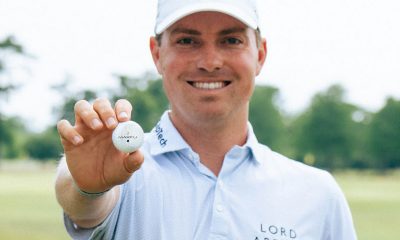Instruction
Golfing Goals: Do they work… or is there a better way?

Sometime after The Masters and before golf season gets into full swing, golfers write down their goals for the summer; win the club championship, finish top-5 in the National Championship, make the National Team, etc. But is goal-setting helpful? Does setting specific tournament results assist golfers in achieving them? Did Tommy Fleetwood sit down at the beginning of 2017 and write out that he would like to win the Race to Dubai and win three tournaments?
There’s a now famous story of Rory McIlroy writing out his goals for the year on the back of an Emirates Airline boarding pass, but in my conversations with European Tour players I’ve found the practice to be the exception, not the rule. I’ve asked the goal-setting question to former World No. 1 players Luke Donald, Lee Westwood and Adam Scott. I’ve even asked Tom Watson about it when sitting down for breakfast with him at the 2014 British Open. Very few top golfers formally write down specific goals on a sheet of paper at the start of a year.
So why is goal-setting not an essential tool? After all, most sports psychologists encourage their clients to do this ritual. I believe goal-setting has a place for some players, but for many players it can also create counter-productive expectations. Anyone who has read my Elite Performance Workbooks knows that I see expectations or “performance demands” as a cancer for elite players.
Being a world class tournament golfer is a performance art that’s akin to being a great chef; it’s about having quality ingredients that are cooked in the right way and at the right time if you hope to create a great dish. So while I’m not a fan of goal-setting, I do believe that it’s very important for players to have a vision. Luke Donald, Lee Westwood, Adam Scott and Tom Watson all have had a great vision of what they wanted to achieve.
So what is the difference between a vision and a goal?
For me, a vision is a picture in your mind of what’s possible. A goal is more rigid and inflexible. It’s black and white. You either achieve it or you don’t. The difference is subtle — and so is the difference between success and failure at elite level. That’s why I like players at the beginning of each season to build a vision instead of creating black-and-white goals. I also like to see them describe their vision for three different parameters:
- An OK Season
- A GOOD Season
- A GREAT Season
As golfers, there are many things not directly in our control: injury, outside golf life things, etc. Having a vision with three different parameters does not induce the pressure that goal setting can. Instead, it creates a motivating picture of clarity that the mind can gravitate toward, and having clarity in your vision of where you are going and how you are going to get there is such an important part of the performance jigsaw puzzle.
What happens once you’ve created this vision? First, I want you to pin it up on your wall or your bathroom mirror (so you’re guaranteed to see it twice a day when you brush your teeth). Each day, you should be visualizing your OK and GREAT visions being achieved and grow this picture in your mind in rich detail. I call this “watering your dream daily,” and it’s hugely important if you want your dream to flower. Many months from now, you may be just be eating your holiday dinner and recounting to your distant relatives how this was your best golf season ever.
Thanks for reading, and here is a Vision Map PDF you can download to help you build YOUR vision for 2018.
- LIKE11
- LEGIT1
- WOW0
- LOL0
- IDHT0
- FLOP1
- OB1
- SHANK4
Instruction
Clement: Laid-off or perfect fade? Across-the-line or perfect draw?

Some call the image on the left laid off, but if you are hitting a fade, this could be a perfect backswing for it! Same for across the line for a draw! Stop racking your brain with perceived mistakes and simply match backswing to shot shape!
- LIKE0
- LEGIT0
- WOW0
- LOL0
- IDHT0
- FLOP0
- OB0
- SHANK1
Instruction
The Wedge Guy: The easiest-to-learn golf basic

My golf learning began with this simple fact – if you don’t have a fundamentally sound hold on the golf club, it is practically impossible for your body to execute a fundamentally sound golf swing. I’m still a big believer that the golf swing is much easier to execute if you begin with the proper hold on the club.
As you might imagine, I come into contact with hundreds of golfers of all skill levels. And it is very rare to see a good player with a bad hold on the golf club. There are some exceptions, for sure, but they are very few and very far between, and they typically have beat so many balls with their poor grip that they’ve found a way to work around it.
The reality of biophysics is that the body moves only in certain ways – and the particulars of the way you hold the golf club can totally prevent a sound swing motion that allows the club to release properly through the impact zone. The wonderful thing is that anyone can learn how to put a fundamentally sound hold on the golf club, and you can practice it anywhere your hands are not otherwise engaged, like watching TV or just sitting and relaxing.
Whether you prefer an overlap, interlock or full-finger (not baseball!) grip on the club, the same fundamentals apply. Here are the major grip faults I see most often, in the order of the frequency:
Mis-aligned hands
By this I mean that the palms of the two hands are not parallel to each other. Too many golfers have a weak left hand and strong right, or vice versa. The easiest way to learn how to hold the club with your palms aligned properly is to grip a plain wooden ruler or yardstick. It forces the hands to align properly and shows you how that feels. If you grip and re-grip a yardstick several times, then grip a club, you’ll see that the learning curve is almost immediate.
The position of the grip in the upper/left hand
I also observe many golfers who have the butt of the grip too far into the heel pad of the upper hand (the left hand for right-handed players). It’s amazing how much easier it is to release the club through the ball if even 1/4-1/2″ of the butt is beyond the left heel pad. Try this yourself to see what I mean. Swing the club freely with just your left hand and notice the difference in its release from when you hold it at the end of the grip, versus gripping down even a half inch.
To help you really understand how this works, go to the range and hit shots with your five-iron gripped down a full inch to make the club the same length as your seven-iron. You will probably see an amazing shot shape difference, and likely not see as much distance loss as you would expect.
Too much lower (right) hand on the club
It seems like almost all golfers of 8-10 handicap or higher have the club too far into the palm of the lower hand, because that feels “good” if you are trying to control the path of the clubhead to the ball. But the golf swing is not an effort to hit at the ball – it is a swing of the club. The proper hold on the club has the grip underneath the pad at the base of the fingers. This will likely feel “weak” to you — like you cannot control the club like that. EXACTLY. You should not be trying to control the club with your lower/master hand.
Gripping too tightly
Nearly all golfers hold the club too tightly, which tenses up the forearms and prevents a proper release of the club through impact. In order for the club to move back and through properly, you must feel that the club is controlled by the last three fingers of the upper hand, and the middle two fingers of the lower hand. If you engage your thumbs and forefingers in “holding” the club, the result will almost always be a grip that is too tight. Try this for yourself. Hold the club in your upper hand only, and squeeze firmly with just the last three fingers, with the forefinger and thumb off the club entirely. You have good control, but your forearms are not tense. Then begin to squeeze down with your thumb and forefinger and observe the tensing of the entire forearm. This is the way we are made, so the key to preventing tenseness in the arms is to hold the club very lightly with the “pinchers” — the thumbs and forefingers.
So, those are what I believe are the four fundamentals of a good grip. Anyone can learn them in their home or office very quickly. There is no easier way to improve your ball striking consistency and add distance than giving more attention to the way you hold the golf club.
More from the Wedge Guy
- The Wedge Guy: Golf mastery begins with your wedge game
- The Wedge Guy: Why golf is 20 times harder than brain surgery
- The Wedge Guy: Musings on the golf ball rollback
- LIKE88
- LEGIT14
- WOW6
- LOL1
- IDHT0
- FLOP4
- OB1
- SHANK8
Instruction
Clement: Stop ripping off your swing with this drill!

Not the dreaded headcover under the armpit drill! As if your body is defective and can’t function by itself! Have you seen how incredible the human machine is with all the incredible feats of agility all kinds of athletes are accomplishing? You think your body is so defective (the good Lord is laughing his head off at you) that it needs a headcover tucked under the armpit so you can swing like T-Rex?
- LIKE0
- LEGIT3
- WOW2
- LOL0
- IDHT0
- FLOP0
- OB0
- SHANK2
-

 19th Hole1 week ago
19th Hole1 week agoJustin Thomas on the equipment choice of Scottie Scheffler that he thinks is ‘weird’
-

 19th Hole1 week ago
19th Hole1 week ago‘Absolutely crazy’ – Major champ lays into Patrick Cantlay over his decision on final hole of RBC Heritage
-

 19th Hole2 weeks ago
19th Hole2 weeks agoTwo star names reportedly blanked Jon Rahm all week at the Masters
-

 19th Hole2 weeks ago
19th Hole2 weeks agoReport: LIV Golf identifies latest star name they hope to sign to breakaway tour
-

 19th Hole2 weeks ago
19th Hole2 weeks agoNeal Shipley presser ends in awkward fashion after reporter claims Tiger handed him note on 8th fairway
-

 19th Hole2 weeks ago
19th Hole2 weeks agoBrandel Chamblee has ‘no doubt’ who started the McIlroy/LIV rumor and why
-

 Equipment3 weeks ago
Equipment3 weeks agoWhat we know about Bryson DeChambeau’s 3D-printed Avoda irons
-

 19th Hole6 days ago
19th Hole6 days agoLET pro gives detailed financial breakdown of first week on tour…and the net result may shock you























